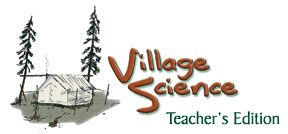|
Teacher
Edition Contents
Skill,
Tools, & Craftsmanship
Cutting
& Drying Fish
Sharpening
Nails,
Pegs, & Lashings
Falling
Trees &
Small-Scale
Logging
Guns
Chainsaw
Clutch & Chain
Ice
Pick
Shelters
Wood
Stoves
Wall
Tents
Steambaths
Insulation
& Vapor Barriers
Gas
Lamps & Gas Stoves
Travel
Piloting
A Boat
Boat
Design
Magnetos
& Spark Plugs
Carburetors
Compression
Outboard
Motor Lower Unit
Outboard
Motor Cooling System
Dogsleds
Snowmachine
Tracks
Snowmachine
Clutch
Snowshoes
Winter
Trails
|
Activities
- Break trail with snowshoes in powder snow. Walk back along the
same trail within an hour. Walk the same trail the next day if
it has been cold. What differences do you notice?
In an hour the trail is still soft. The trail sets up and
gets hard overnight.
- Ask oldtimers in the village how they used the fact that trails
set up overnight in planning their travels.
- Ask old people in the village how they can tell which way a
moose or caribou has gone even after the track is blown over.
How does this relate to the above activities?
Snow that is compressed sets up hard. Poke both sides of a
moose track in the snow. The direction the moose is going will
be hard. The direction it came from is soft.
- Observe trails as they emerge “high centered” in
March. Ask oldtimers if this was as big a problem with dog teams
as it is with snowmachines.
I think it was harder with dog teams.
- Stand on a packed trail. With your eyes closed and a long stick
in your hand, can you feel the trail and walk for 200 yards? Do
you think you could find a trail that is blown over on a lake
or the river by this method?
- Design a rig that could be pulled behind a snowmachine that
would smooth out the bumps in the snowmachine trail. Think about
hidden stumps and the need to adjust height.
- Ask the experienced snowmachine operators in your village for
stories about overflow. How do they get out when they get stuck?
What months does overflow start in your area?
- Find out if there are people in your village who fell through
the ice and how they survived.
- How do people get snowmachines out that fall through the ice?
Do the machines usually run after they have been underwater for
a while? How do people know where to look for the machine in the
open water?
Some times there is a small oil slick above the machine as
gasoline leaks out of the tank.
- After breakup, check the ice chunks on the sides of the river.
Break them with a stick. Can you see how different it is from
the fall ice? Do you think two feet of that kind of ice is strong?
Not at all. The crystals don’t hold well together at all.
- From the oldtimers, ask about five places that usually have
bad ice in your area. How do they tell bad ice right after freeze-up?
During the winter after snow covers the ice? In the spring?
In the fall, test with an icepick. In the winter, look for indentations
to indicate that the ice has melted out from under the trail.
In the spring, bad ice tends to be darker. Stong ice is whiter.
- Draw a picture of overflow as you imag e it under the snow on
the river.
Student Response
- Why did people with dog teams break trail one day and haul a
load on the next day?
The trail will set up overnight.
- Which is harder, breaking trail with an empty sled or hauling
a load on a firm trail?
Breaking trail with an empty sled.
- How did oldtimers find a trail that was blown over?
With a stick, feeling through the drifted snow for the hardpacked
trail beneath.
- Draw the process that causes a trail to become high centered
in March and April.
- Why doesn’t overflow freeze under the snow?
Snow is an excellent insulator.
- What did dog mushers do when traveling on bad ice?
Spread the dogs out.
- What is the difference between fall and spring ice?
Fall ice tends to be much stronger than the crystallized spring
ice.
Math
- Force = mass x acceleration. A snowmachine has 1/3 of its weight
on the front skis. It weighs 357 lbs. Another machine has 1/4
of its weight on the front skis. It weighs 402 lbs. Which machine
impacts the trail harder when going over a bump?
The 357 lb machine
- Fall ice is 12 times stronger than spring ice. If Aaron can
walk on ice 2 1/2” thick in the fall, how thick must ice
be in the spring to be safe?
17.5”. The figure 7 times stronger is an approximation.
There are many variables.
|
